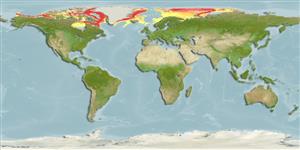Environment: milieu / climate zone / depth range / distribution range
Ecologia
marino batidemersale; distribuzione batimetrica 50 - 1400 m (Ref. 117245). Deep-water; 80°N - 58°N, 161°W - 104°E (Ref. 117245)
Northeast Atlantic: eastern central Greenland southeast to just north of the Faroes, Jan Mayen Island, around Spitsbergen and northern parts of Barents Sea. Arctic: Franklin Bay, North Western Territory and Alaska (Ref. 11976); also the Kara and Beaufort seas.
Size / Peso / Age
Maturity: Lm ? range ? - ? cm
Max length : 51.7 cm TL maschio/sesso non determinato; (Ref. 11976)
Short description
Morfologia | Morfometria
Vertebre: 96. Pelvic fins small (Ref. 4695). Uniformly or mostly dark, with 5-8 short, light cross-bands; band across nape, if present, straight, not curved forward; peritoneum dark, with dense brownish-black dots (Ref. 4695).
Found on muddy bottoms (Ref. 4695). Benthic (Ref. 58426). Feeds mainly on epibenthic animals. With increase in size, shrimps and euphausiids are ingested in greater quantities but unlike L. reticulatus, its ingestion of smaller prey items does not decrease. Changes in feeding habit with size are relatively small (Ref. 13532).
Life cycle and mating behavior
Maturità | Riproduzione | Deposizione | Uova | Fecundity | Larve
McAllister, D.E., M.E. Anderson and J.G. Hunter, 1981. Deep-water eelpouts, Zoarcidae, from Arctic Canada and Alaska. Can. J. Fish. Aquat. Sci. 38(7):821-839. (Ref. 11976)
IUCN Red List Status (Ref. 130435)
Threat to humans
Harmless
Human uses
Informazioni ulteriori
BibliografiaAcquacolturaProfilo di acquacolturaVarietàGeneticaElectrophoresesEreditarietàMalattieElaborazioneNutrientsMass conversion
CollaboratoriImmaginiStamps, Coins Misc.SuoniCiguateraVelocitàModalità di nuotoArea branchialeOtolithsCervelliVista
Strumenti
Special reports
Download XML
Fonti Internet
Estimates based on models
Preferred temperature (Ref.
123201): -0.7 - 2.6, mean 0.4 °C (based on 489 cells).
Phylogenetic diversity index (Ref.
82804): PD
50 = 0.5000 [Uniqueness, from 0.5 = low to 2.0 = high].
Bayesian length-weight: a=0.00275 (0.00171 - 0.00444), b=3.20 (3.06 - 3.34), in cm total length, based on LWR estimates for this species & Genus-body shape (Ref.
93245).
Trophic level (Ref.
69278): 3.4 ±0.44 se; based on food items.
Resilienza (Ref.
120179): Molto basso, tempo minimo di raddoppiamento della popolazione più di 14 anni (Preliminary K or Fecundity.).
Fishing Vulnerability (Ref.
59153): Moderate vulnerability (41 of 100).
